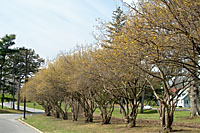Terry L. Ettinger Horticulture Consulting Services
Meeting The Needs Of Today With A Vision For The Future
Recommended Shrubs -
Corneliancherry
 Depending on the
weather, it's not unusual for the clusters of tiny yellow flowers of this large shrub (or small tree, depending upon how it's managed) to
open the better part of a month before the way-overplanted forsythia
all across upstate New York - in some years as early as the last week or so in March!
Depending on the
weather, it's not unusual for the clusters of tiny yellow flowers of this large shrub (or small tree, depending upon how it's managed) to
open the better part of a month before the way-overplanted forsythia
all across upstate New York - in some years as early as the last week or so in March!
Native to southern Europe and Eurasia, Corneliancherry (Cornus mas) is a true dogwood, and therefore closely related to our native gray, redtwig and pagoda dogwoods - as well as the flowering dogwood and increasingly popular Kousa dogwood trees. Unlike flowering dogwood, however, this plant will grow almost anywhere you might plant it - except for spots where the soil is constantly damp to wet.
 It was
probably
first cultivated for it's late summer bounty of juicy, bright red fruit,
at left. While they're not particularly tasty when
eaten right off the plant, they've reportedly been used for making preserves and syrups.
And, while we may not enjoy the fresh fruit, birds certainly do!
It's just too bad the olive-sized fruit are hidden by leaves as they
ripen, otherwise, there's no doubt this plant would much more common
in landscape settings.
It was
probably
first cultivated for it's late summer bounty of juicy, bright red fruit,
at left. While they're not particularly tasty when
eaten right off the plant, they've reportedly been used for making preserves and syrups.
And, while we may not enjoy the fresh fruit, birds certainly do!
It's just too bad the olive-sized fruit are hidden by leaves as they
ripen, otherwise, there's no doubt this plant would much more common
in landscape settings.
 Because
of it's "shrubby," multiple-stemmed habit, corneliancherry is
generally classified as a shrub. However, it's hardly small and can,
in fact, grow twenty feet tall with a similar spread over the course
of
fifteen to twenty years! The row of mature corneliancherry, at
right, are located in Burnet Park in Syracuse, and are likely forty
to fifty years old.
Because
of it's "shrubby," multiple-stemmed habit, corneliancherry is
generally classified as a shrub. However, it's hardly small and can,
in fact, grow twenty feet tall with a similar spread over the course
of
fifteen to twenty years! The row of mature corneliancherry, at
right, are located in Burnet Park in Syracuse, and are likely forty
to fifty years old.
The most common cultivated variety (cultivar) of corneliancherry is `Golden Glory,' which is reported to be more upright growing than the species. There are also at least two variegated forms according to the literature, but I've never seen either of them and they're quite difficult to track down in commerce.
While the the ornamental traits of corneliancherry will never stop traffic, its early spring flowers and tough-as-nails constitution will put this plant on my recommended list every time!